A History of Wood-Engraving/Chapter 8
VIII.
MODERN WOOD-ENGRAVING.
 Fig. 60.—From the "Comedia di Danthe." Venice, 1536.HE revival of the art began in England, in the workshop of Thomas Bewick (1753–1828). He is called, not without justice, the father of the true art of engraving in wood. The history of the art in the older time is concerned mainly with the designer and the ideas which he endeavored to convey, and only slightly with the engraver whom he employed for the mechanical work of cutting the block. In the modern art the engraver holds a more prominent position, because he is no longer restricted to a servile following of the designer’s work, line for line, but has an opportunity to show his own artistic powers. This change was brought about by the invention of white line, as it is called, which was first used by Bewick. White line was a new mechanical mode of obtaining color. “I could never discover,” says Bewick, “any additional beauty or color that the cross-strokes gave to the impression beyond the effect produced by plain parallel lines. This is very apparent when to a certainty the plain surface of the wood will print as black as ink and balls can make it, without any farther labor at all; and it may easily be seen that the thinnest strokes cut upon the plain surface will throw some light on the subject or design; and if these strokes again are made still wider or of equal thickness to the black lines, the color these produce will be a gray; and the more the white strokes are thickened, the nearer will they in their varied shadings approach to white; and if quite taken away, then a perfect white is obtained.” The practical difference between the two methods is this: by the old method, after the simple work in outline of the early Italian engravers had been relinquished for the style of which Dürer was the great master, the block was treated as a white surface, on which the designer drew with pen and ink, and obtained grays and blacks by increasing the number of cross-strokes, as if he were drawing on paper; by the new method the block was treated as a black surface, and the color was lessened by increasing the number of white lines. The latter process was as easy for the engraver as the former was difficult, because whereas in the former he had to gouge out the diamond spaces between the crossing lines, now he obtained white color by single strokes of the graver. Bewick may have been led into the use of white line simply by this consideration of the economy of labor, because he engraved his own designs, and was directly sensible of the waste of labor involved in the old method. In both methods color depends, of course, upon the relative quantity of black and white in the prints; the new method merely arranges color differently, so that it can be obtained by an easy mechanical process instead of by a difficult one.
Fig. 60.—From the "Comedia di Danthe." Venice, 1536.HE revival of the art began in England, in the workshop of Thomas Bewick (1753–1828). He is called, not without justice, the father of the true art of engraving in wood. The history of the art in the older time is concerned mainly with the designer and the ideas which he endeavored to convey, and only slightly with the engraver whom he employed for the mechanical work of cutting the block. In the modern art the engraver holds a more prominent position, because he is no longer restricted to a servile following of the designer’s work, line for line, but has an opportunity to show his own artistic powers. This change was brought about by the invention of white line, as it is called, which was first used by Bewick. White line was a new mechanical mode of obtaining color. “I could never discover,” says Bewick, “any additional beauty or color that the cross-strokes gave to the impression beyond the effect produced by plain parallel lines. This is very apparent when to a certainty the plain surface of the wood will print as black as ink and balls can make it, without any farther labor at all; and it may easily be seen that the thinnest strokes cut upon the plain surface will throw some light on the subject or design; and if these strokes again are made still wider or of equal thickness to the black lines, the color these produce will be a gray; and the more the white strokes are thickened, the nearer will they in their varied shadings approach to white; and if quite taken away, then a perfect white is obtained.” The practical difference between the two methods is this: by the old method, after the simple work in outline of the early Italian engravers had been relinquished for the style of which Dürer was the great master, the block was treated as a white surface, on which the designer drew with pen and ink, and obtained grays and blacks by increasing the number of cross-strokes, as if he were drawing on paper; by the new method the block was treated as a black surface, and the color was lessened by increasing the number of white lines. The latter process was as easy for the engraver as the former was difficult, because whereas in the former he had to gouge out the diamond spaces between the crossing lines, now he obtained white color by single strokes of the graver. Bewick may have been led into the use of white line simply by this consideration of the economy of labor, because he engraved his own designs, and was directly sensible of the waste of labor involved in the old method. In both methods color depends, of course, upon the relative quantity of black and white in the prints; the new method merely arranges color differently, so that it can be obtained by an easy mechanical process instead of by a difficult one.
The use of white line not only affected the art by making it more easy to practise, but also involved a change in the mode of drawing. Formerly the effects were given by the designers’ lines, now they were given by the engravers’ lines; in other words, the old workman followed the designer’s drawing, the modern workman draws himself with his graver. By the old method the design was reproduced by keeping the same line-arrangement that the artist employed; by the new method the design is not thus reproduced, but is interpreted by a line-arrangement first conceived by the engraver. In the earlier period the design had to be a drawing in line for the engraver to cut out and reproduce by leaving the original lines in relief; now the design may be a washed sketch, the tints of which the engraver reproduces by cutting lines of his own in intaglio. The change required the modern engraver to understand how to arrange white lines so as to obtain artistic effects; he thus becomes an artist in proportion to his knowledge and skill in such arrangement. It is clear that, no matter how much mechanical skill, firmness, justness and delicacy of touch were requisite in the older manner of following carefully and precisely the lines already drawn upon the block, still the engraver was precluded from exercising any original artistic power he might have; he could appreciate the artistic value of the design before him, and, like Hans Lützelburger, show his appreciation by his fidelity in rendering it, but the lines were not his own. The new method of reproducing artists’ work by means of lines first conceived and arranged by the engraver requires, besides skill of hand, qualities of mind—perception and origination, and the judgment that results from cultivated taste. This is what is meant when it is said that the true art of wood-engraving is not a hundred years old, for it is only within that time that the value of a print has been due to the engraver’s capacity for thought and his artistic skill in line-arrangement, as well as to the designer’s genius. The use of white line as a mechanical mode of obtaining color was not unknown in the sixteenth century, and the artistic value of white line was definitely felt in early French and Italian wood-engraving; but the possibilities of development were not seen, and no such development took place. The step in advance was taken by Bewick, who thus disclosed the opportunities which wood-engraving offers its craftsmen for the exhibition of high artistic qualities. The white line revolutionized the art, and this is the essential meaning there is in calling Bewick the father of wood-engraving.
Of course the older method has not ceased to be practised; artists have drawn upon the block, and their lines have been reproduced; sometimes a part of the lines are thus drawn, particularly the leading lines, and the minor portions of the sketch have been indicated by the designer by washes and left to be rendered by the engraver in his own lines. Old or modern wood-engraving as a mode of reproducing designs in facsimile is valuable, but none of the artistic merit they may possess is due to the engraver; while the artistic merit shown in the new style of wood-engraving, as an art of design in white line, belongs wholly to the engraver. It results from this that white line is the peculiar province of wood-engraving, considered as an art; but that does not exclude it from being practised in its old manner as a mode of copying and multiplying ordinary design which it is able to reproduce.
Thomas Bewick, the founder of the modern art, was born near Newcastle in 1753. He passed his boyhood in rude country life and received scanty schooling. At fourteen he was bound apprentice to the Newcastle engraver, Ralph Beilby; nine years later he went to seek his fortune in London, where he impatiently endured city life for less than a year; in the summer of 1777 he returned to his old master, with whom he went into partnership. Some preliminary training in book-illustration of the rude sort then in vogue was necessary to reveal his powers to himself; he received a premium from the Society for the Encouragement of Arts, which had shown some interest in wood-engraving; and after farther minor work he began, in 1785, to engrave the first block for his British Quadrupeds, which, with his British Birds, although his other cuts are numbered by thousands, is the principal monument of his genius. When he took the graver in his hand he found the art extinct as a fine art; at most only large coarse prints were manufactured. Besides his great service to the art in introducing the white line he substituted boxwood for the pear or other soft wood of the earlier blocks, and he engraved across the grain instead of with it, or “the plank way of the wood,” as he called it; he also began the practice of lowering the surface of the block in places where less color was desired, so that less pressure would come upon those parts in printing (a device which Aldegrever is believed to have resorted to in some of his works), and he used the dabber instead of the inking-roller.
By such means he was truly, as Ruskin says, “a reformer”—Ruskin adds, “as stout as Holbein, or Botticelli, or Luther, or Savonarola,” and this is also true within limits. But if in relation to his art, and in answer to the tests rerequired of him, his reforming spirit proved itself vigorous, independent, persistent in conviction, and faithful in practice, his natural endowment in other ways was so far inferior to those of the great Reformers named as to place him
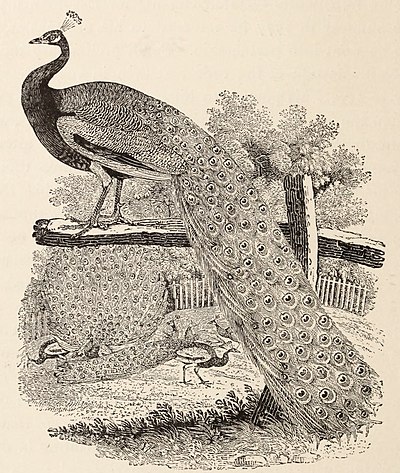
Fig. 61.—The Peacock. From Bewick’s "British Birds."
in a different order of men. He had not a spark of the philosophic spirit of Holbein, and but a faint glimmer of Holbein’s dramatic insight. He was not endowed with the romantic imagination, the deep reflective power, the broad intellectual and moral sympathy of Dürer. There is no need to magnify his genius, for it was great and valuable by its own right. He was, primarily, an observer of nature, and he copied natural facts with straightforward veracity;
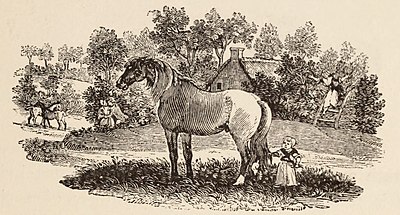
Fig. 62.—The Frightened Mother. From Bewick’s “British Quadrupeds.”
he delineated animal life with marvellous spirit; he knew the value of the texture of a bird’s feather (Fig. 61) as no one before ever realized it. He was open also to the influence which nature exerts over the emotions, and he rendered the sentiment of the landscape as few engravers have been able to do. His hearty spirit responded to country sights (Fig. 62), and he portrayed the humorous with zest and pleasure, as well as the cheerful and the melancholy

Fig. 63.—The Solitary Cormorant. From Bewick’s “British Birds.”
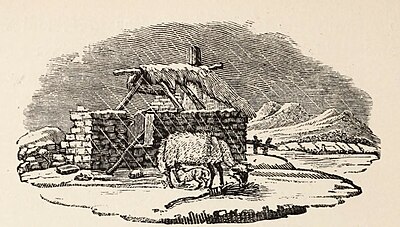
Fig. 64.—The Snow Cottage.
with truth and feeling; his humor is sometimes indelicate, but it is faithful; usually it is the humor of a situation which strikes him, seldom the higher humor which appears

Fig. 65.—Birth-place of Bewick. His last vignette, portraying his own funeral.
in such cuts as the superstitious dog. He is open to pathos, too, but here it is not the higher order of pathos far-reaching into the bases of life and emotion—in this cut (Fig. 64), for example, one fancies his heart is nearly altogether with the uncared-for animal, and takes not much thought of the deserted hearth. With this veracity, sensitiveness, heartiness, there is also an unbending virtue—a little like preaching sometimes, with its gallows in the background—but sturdy and homely; not rising into any eloquent homily, but with indignation for the boys drowning a cat or the man beating his overdriven horse.
As an artist he knows, like Holbein, the method of great art. His economy of labor, his simplicity, justness, and sureness of stroke show the master’s hand. There was no waste in his work, no ineffective effort after impossible results, no meaningless lines. For these excellences of method and of character he has been often praised, especially because he developed his talents under very unfavorable conditions; but perhaps no words would have been sweeter to him than those which Charlotte Brontë wrote, sincerely out of her own experience without doubt, for he himself said he was led to his task by “the hope of administering to the pleasure and amusement of youth.” Charlotte Brontë, speaking through the lips of Jane Eyre of the pleasure she took as a child in looking through Bewick’s books, writes thus:
“I returned to my book—Bewick’s History of British Birds, the letterpress whereof I cared little for, generally speaking; and yet there were certain introductory pages that, child as I was, I could not pass quite as a blank: they were those which treat of the haunts of sea-fowl; of ‘the solitary rocks and promontories’ by them only inhabited; of the coast of Norway, studded with isles from its southern extremity, the Lindeness, or Naze, to the North Cape—
Nor could I pass unnoticed the suggestion of the black shores of Lapland, Siberia, Spitzbergen, Nova Zembla, Iceland, Greenland. * * * Of these death-white realms I formed an idea of my own—shadowy, like all the half-comprehended notions that float dim through children’s brains, but strangely impressive.

Fig. 66.—The Broken Boat. From Bewick’s “British Birds.”
The words in these introductory pages connected themselves with the succeeding vignettes, and gave significance to the rock standing up alone in a sea of billow and spray; to the broken boat (Fig. 66) stranded on a desolate coast; to the cold and ghastly moon glancing through bars of cloud at a wreck just sinking. I cannot tell what sentiment haunted the quiet, solitary church-yard (Fig. 67), with its inscribed head-stone, its gate, its two trees, its low horizon, girdled by a broken wall, and its newly risen crescent
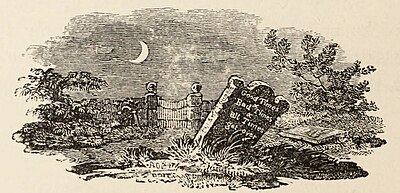
Fig. 67.—The Church-yard. From Bewick’s “British Birds.”
attesting the hour of even-tide. The two ships becalmed on a torpid sea I believed to be marine phantoms. The fiend pinning down the thief’s pack behind him I passed over quickly: it was an object of terror. So was the black, horned thing, seated aloof on a rock, surveying a distant crowd surrounding a gallows. Each picture told a story—mysterious often to my undeveloped understanding and imperfect feelings, yet ever profoundly interesting. * * * With Bewick on my knee, I was then happy; happy at least in my way.”
Bewick published the first edition of the British Quadrupeds in 1790, the first edition of the first volume of the British Birds in 1797, and of the second volume in 1804; all these became popular, and were several times republished with additional cuts. His other works were very numerous, but, as a whole, they are of inferior value. Both in the volumes which have been mentioned and in his later work he received much aid from his pupils, who designed and engraved, subject to his correction and approval, many illustrations which are ascribed to him. In his own work, notwithstanding his great excellence, he was by no means perfect. In delineating rocks and the bark of trees, especially, he fails; in drawing he sometimes makes errors, particularly when what he represents was not subject to direct and frequent observation; in the knowledge of line-arrangement, too, he is less masterly than some of his successors, and, in this respect, his work is characterized by effectiveness and spirit rather than by finish. Yet, when these deductions have been made from his merit, so much remains as to render him, without doubt, the most distinguished modern engraver in wood.
Before Bewick’s death, in 1828, another English genius, William Blake (1758–1827), greater as an artist than as an engraver, produced a series of woodcuts (Fig. 68) which is remarkable for vigor and originality.
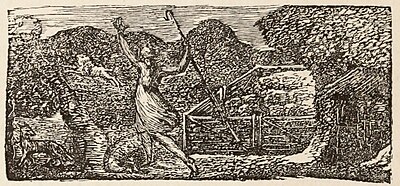
Fig. 68.—The Sheep-fold. By Blake. From Virgil’s Pastorals.
They were published in a reprint of Ambrose Philips’s Imitation of Virgil’s First Eclogue, in Dr. Thornton’s curious edition of Virgil’s Pastorals which appeared in 1820. One of them (Fig. 69) represents a landscape swept by violent wind. The idea of autumnal tempest has seldom been so strikingly and forcibly embodied as in the old gnarled oak straining with laboring limbs, the hedgerows blown like indistinguishable glimmering dust, the keen light of the crescent moon shining through the driving storm upon the rows of laid corn and over the verge of the distant hill. Contemporary
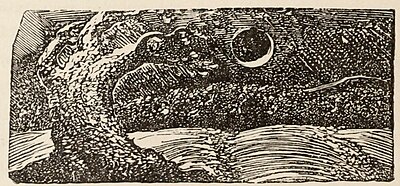
Fig. 69.—The Mark of Storm. By Blake. From Virgil’s Pastorals.
The revival of wood-engraving was not confined to England. At the end of the eighteenth century Prussia founded a chair at Berlin for teaching the art, and made the Ungers, father and son, professors of it; but, although they contributed to the progress of wood-engraving in Germany, no real success was obtained until the time of their successor, Gubitz. In France, too, the Society for the Encouragement of National Industry began to offer prizes for the best wood-engraving as early as 1805; but some years passed before any contestants, who practised the true art, appeared. The publisher Didot deserves much of the credit for reviving French wood-engraving, because he employed Gubitz, and called to Paris the English engravers who really founded the modern French school. The efforts of societies or individuals, however, do not explain the rise of the art in our time. Wood-engraving merely shared in the renewal of life which took place at the end of the last century, and so profoundly affected literature, art, and politics. The barren classical taste disappeared in what is known as the return to nature, the intellectual life of the people was stimulated to extraordinary activity, civilization suffered rapid and important modifications, and every human pursuit and interest received an impulse or a blow. Wood-engraving felt the influence of the change, and came into demand with the other cheap pictorial arts to satisfy popular needs; the interest of the publishers, the improvements in the processes of printing, and the example of Bewick and his pupils especially contributed to bring the old art again into use, and it continued to be practised because its value in democratic civilization was immediately recognized.
England was naturally the country where wood-engraving most flourished. The pupils of Bewick, particularly Charlton Nesbit and Luke Clennell, practised it with great merit, the former with a better knowledge of line -arrangement than Bewick, and the latter with extraordinary artistic feeling. The field, however, was not left wholly to those who had learned the art from Bewick. Robert Branston was, like Bewick, a self-taught wood-engraver; unlike Bewick, who was never trammelled by traditions, and was thus able to work out his own methods in his own way by the light of his own genius, Branston (Fig. 70), who had served an apprenticeship in engraving on copperplate, and had mastered the art of incising and arranging lines proper to that material, came to wood-engraving with all the traditions of copperplate-engraving firmly fixed in his mind and hand, and he founded a school which began where the art had left off at the time of its decline—in the imitation of the methods of engraving on copper. It is true that Branston sometimes admitted white line where he thought it would be effective, but he relied on black line for the most part. The wrong step thus taken led to the next. Engravers on copper began to draw designs on the block for wood-engravers to cut out. John Thurston, the most distinguished of these, drew thus for John Thompson, who, however, did not follow the lines with the servility of the engravers of the sixteenth century, but modified them as he engraved, changed the direction and character of the lines, and 
Fig. 70.— The Cave of Despair. By Branston. From Savage’s “Hints on Decorative Printing.”
occasionally introduced white line. In the same way Clennell, who also engraved after John Thurston’s drawing, modified it, particularly in the disposal of the lights and shadows, and thus improved it by his own artistic powers. Merely in engraving simple lines Clennell’s artistic feeling placed Fig. 71.—Vignette from "Rogers's Poems" London, 1827. him in a higher rank than even an engraver of the power of John Thompson, as may be seen in the cuts which these two men made after Stothard’s drawings in an edition of Rogers’s Poems (Fig. 71, 72); in this volume Clennell has given an effect which Thompson could not give. Branston’s engraving, in the same way, shows the craftsman’s skill and knowledge, but it lacks the artistic quality of the rival school of Nesbit and Clennell. The imitation of the manner of copperplate, which Branston introduced, became common, and was developed in the work of Orrin Smith and William Harvey, in which wood-engraving
Fig. 71.—Vignette from "Rogers's Poems" London, 1827. him in a higher rank than even an engraver of the power of John Thompson, as may be seen in the cuts which these two men made after Stothard’s drawings in an edition of Rogers’s Poems (Fig. 71, 72); in this volume Clennell has given an effect which Thompson could not give. Branston’s engraving, in the same way, shows the craftsman’s skill and knowledge, but it lacks the artistic quality of the rival school of Nesbit and Clennell. The imitation of the manner of copperplate, which Branston introduced, became common, and was developed in the work of Orrin Smith and William Harvey, in which wood-engraving  Fig. 72.—Vignette from "Rogers's Poems" London, 1827.lost its distinctive virtues. This school, nevertheless, was popular, and its engravings were used to illustrate important works to which for a long time copperplate-engraving alone had been considered equal; thus wood-engraving once more encroached upon its rival’s ground.
Fig. 72.—Vignette from "Rogers's Poems" London, 1827.lost its distinctive virtues. This school, nevertheless, was popular, and its engravings were used to illustrate important works to which for a long time copperplate-engraving alone had been considered equal; thus wood-engraving once more encroached upon its rival’s ground.
Meanwhile the great illustrated magazines and papers, to which wood-engraving owes so much of its encouragement, sprang up, and with them the necessity for rapid work, and the temptation to be satisfied with what satisfied the public taste. Cruikshank and Seymour prepared the way for the designers, Leech, Gilbert, Tenniel, and the Dalziels, the latter engravers themselves, and carelessness in engraving accompanied carelessness in drawing; but from the latter charge Tenniel's designs must be excepted. These artists were inferior in natural endowment to even the lesser artists of the sixteenth century, and their work was made worse by the negligent rendering of their engravers, who were not characterized either by the fidelity of the old craftsmen, or the skill and knowledge of Thompson, or the artistic sense of Clennell, but were merely inefficient workmen employed to cut lines drawn for them as rapidly as possible. Mr. Linton made an attempt to introduce the practice of rendering artists' drawings by lines conceived and arranged by the engraver himself; but the current was too strongly set in another direction, and the engraver kept his old position of mechanic employed to clear out the designers' lines. The work which was produced by this method in great quantities was in the mass not valuable either for the art shown in the design or for the skill of the engraver, but derived its interest and popularity from qualities which have little connection with fine art. No great works were produced; and it is only here and there that separate prints of value are to be found, among which those by Edmund Evans in Birket Foster's edition of Cowper's Task deserve to be mentioned.
Upon the Continent the development of wood-engraving was by no means so great as in England, but some excellent work has been done by the pupils of Thompson, who went to Paris by Didot's invitation; these men, of whom MM. Best and Leloir were the most distinguished, together with MM. Brevière, Porret, and Lavoignat, produced some cuts of considerable value both in book-illustration and in the art magazines. In Germany, too, wood-engraving counts

Fig. 73.—Death as a Friend.
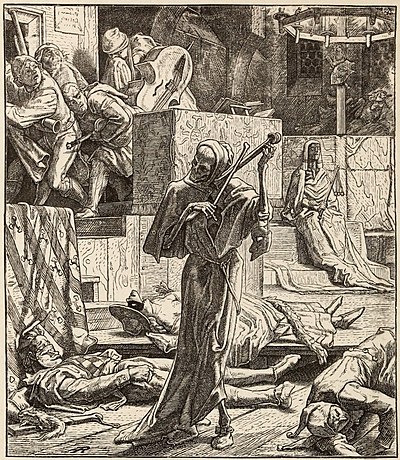
Fig. 74.—Death as a Throttler.
favorable examples, remain inferior for the most part to either the English or French.
Wood-engraving, however, has been practised in our time less as a fine art than as a useful art; and if little that is valuable for artistic worth has been executed by engravers since the days of Nesbit, Clennell, and Thompson, the application of wood-engraving for merely useful purposes has been of the greatest service. It has become a most powerful instrument of popular education; it imparts the largest share of the visual knowledge which the people have of the things they have not directly seen; its utility as a means of instruction by its representation of the objects with which science deals, and the mechanical contrivances and processes which science employs, and also as a means of influence in caricature and of simple popular amusement, is incalculable; and, notwithstanding its low level in art, there can be no doubt that it frequently assists the exercise of the popular imagination, and sometimes generates in the better-endowed minds among the people a real sympathy with the higher products of art and an appreciation of them. These utilities, indeed, so overbalance its value simply as a fine art as to give it a distinctive character, when its practice now is compared with that of any previous time; as, formerly, it reflected the aspects of changing civilization, now it reflects the peculiar character of our time, and shows how great has been the gain in the popular hold upon the material comforts of life and upon intelligence, and how great has been the loss in the community's appreciation of purely artistic results. This is especially true of the earlier American practice of the art, which seldom resulted in any work of artistic value.
The history of wood-engraving in America, until recent years, is comparatively insignificant. In art, as in literature, the first generation of the Republic followed the English tradition almost slavishly; the engravers, indeed, showed hardly any individuality, and left no work of permanent value. During Colonial times some very rude apprentice-work on metal had been produced; but the first certain engraving in wood bears date of 1794, and was from the hand of Dr. Alexander Anderson (1775–1870), a physician by profession, but with a natural bent toward the art, which he had played at from boyhood, and finally made the principal business of his life. The sight of some of Bewick’s early
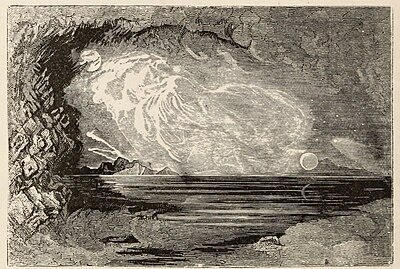
Fig. 75.—The Creation. Engraved by J. F. Adams.
work had determined him to employ wood as a material in place of the type-metal on which he had previously engraved in relief, and the example of Bewick taught him to use white line. At that time, and for many years afterward, the art was applied mainly to the production of cuts for advertisements, labels, and the like, as a servant of trade; its use for illustration simply was confined almost wholly to juvenile books. The engravers who at the beginning of the century introduced the art in New York, Boston, Philadelphia, Baltimore, and New Haven were few, and, for the most part, self-taught; usually they merely copied English cuts, and thus they reflected in their poorer work the manner of successive English schools; but at least they kept the art alive, and handed it on through their pupils. Dr. Anderson was the best of them; yet, although he was free and bold in his handling of white line, and once or twice attained an excellence that proved him a worthy pupil of Bewick, he left nothing of enduring interest, and the work of his fellows met with even swifter forgetfulness. Woodcuts of really high value were not produced in America until Joseph Alexander Adams (b. 1803), one of the young engravers encouraged by Dr. Anderson, began to do his best work (Figs. 75, 76), about

Fig. 76.—The Deluge. Engraved by J. F. Adams.
1834, and applied his talents to the illustration of the Bible, published by the Harper Brothers in 1843, with which wood-engraving may be properly said to have begun its great career in this country. This volume was embellished by sixteen hundred cuts, executed under the supervision of Mr. Adams, and plainly exhibits the capacities and limitations of the art at that time. Other illustrated books followed this from the same press, and from that of the Putnams; the cuts in the papers and magazines, established during the second quarter of the century, became more numerous, and the attention paid by the American Tract Society to the engravings in its various publications had great influence in encouraging and improving the art. The work of this first half-century, however, as a whole, does not deserve any great praise; in judging it, the inexperience of the engravers and the difficulties of printing must be remembered; but in its inferior portions it is marked by feebleness and coarseness, and in its better portion by a hardness and stiffness of line, a lack of variety and gradation in tone and tint, and a defect in vivacity and finish. There are here and there exceptional cuts to which these strictures would not apply, but the body of the work is vitiated either through an incomplete control of his materials by the engraver, or through an evil imitation of copperplate-drawing by the designer. Where the engraver was also the designer the work is usually of higher value.
With the second half of the century began that expansion of the press, that increase in the volume and improvement in the quality of the reading provided for the public through newspapers and magazines, which has been one of the most striking and important results of democratic institutions. The Harpers' Monthly Magazine was established in 1850, and it was followed within a decade by several illustrated periodicals; during the civil war there was naturally a slackening in this development, but, upon its close, numerous new illustrated weekly or monthly publications began their 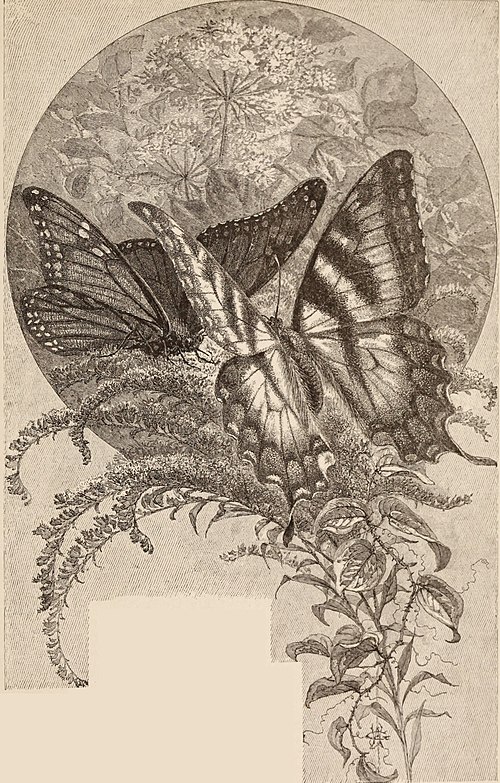
Fig. 77.—Butterflies
Engraved by F. S. King.
longer or shorter career,
among them those
issued by the Scribners, which were
to have so important a bearing
on the history of wood-engraving.
The art naturally received a great impetus from this demand upon its resources; it rapidly advanced; and being encouraged farther by the popularity of the new and beautifully illustrated gift-books of the Boston and New York publishers, it has taken the leading place in the artistic interests of the country.
The scope of this volume does not allow any detailed account of the works of American engravers individually; but while the increased productiveness and improved technique of the art during the third quarter of the century are being noticed, it would be unjust to make no mention of the quiet, careful, and refined woodcuts of Mr. Anthony, or of the long and unflinching fidelity of Mr. Linton, with its reward in admirable work, or of the exquisite skill of Mr. Henry Marsh, the best of American engravers of that period. The latter’s marvellous rendering of insect life in the illustrations to Harris’s Insects Injurious-to Vegetation, published in 1862, can never be forgotten by any who have been fortunate enough to see the artist-proofs. His work is in the manner of copperplate-engraving, and affords one of the few instances in which wood-engraving has equalled the rival art in fineness, delicacy, softness, and gradation of tone. Whatever the critic’s theory may be, he must remember that genius has a higher validity than reason, and must acknowledge such work as this to be its own justification. Unfortunately, the cuts in the published volume were not—perhaps at that time could not be—printed with the success they deserved. The work of these three engravers illustrates what advance had already been made in skilful line-arrangement and in technique before 1870, about which time the indications of an approaching change in the art 
Fig. 78.—Engraved by F. S. King
became plainly evident. Since then progress has been uninterrupted, swift, marked by bold experiments and startling surprises. Now American engravers excel all others in knowledge of the resources of their art, and in control of its materials, as well as in the interest of their work. They have not, it is true, produced, as yet, anything to rank in artistic value with the designs of the older masters; but, in their hands, the art has gained a width and utility of influence among our people hitherto unequalled in any nation at any period. From the beginning of its history wood-engraving has been distinctively a democratic art; at present the ease and cheapness of its processes and the variety of its applications make it one of the most accessible sources of inexpensive information and pleasure; for this reason it has acquired in our country, where a reading middle class forms the larger portion of the nation, a popular influence of such far-reaching and penetrative power as to make it a living art in a sense which none other of the fine arts can claim. It now enters into the intellectual life and enjoyment of our people to a degree and with a constancy impossible to other arts. In this respect, too, it is only at the beginning of its career; for, as popular education spreads, the place that the art holds in the national life will continually become more important. These social conditions, the technical skill of the engravers, and the appearance among the people of a critical spirit concerning their work—not perhaps to be called intelligent as yet, but forming, nascent, feeling its way into conscious and active life—make up a group of most favorable circumstances for a real artistic development. Whether such a development will take place depends in large measure on the clearness with which engravers understand the laws of their art, as presented by their materials, and on the degree in which such knowledge controls them. The experiments of recent years are to be judged finally by the results; but, in spite of the novel effects obtained, and of the new character that has been given to the art, there is at present no such unanimity, either among the engravers or the public, as to be decisive of the worth of the new work as a whole. While the issue is still doubtful, and the stake is the future of the only art by which those who care for the growth of civilization can develop in the people a sense of art, bring them to an appreciation of its value, open their understandings to its teachings, and fill their lives with its delights, something may be gained by recurring to fundamental principles, as illustrated by the practice of the older masters, not with an end to limit the future by the past, but to foresee it. Such a brief review and summary of past thought respecting the aims and methods of wood-engraving, with such corrections as modern improvements in processes justify, will afford the surest ground for criticism of the work still to be considered.
All the graphic arts have to do with some one or more of the three modes under which nature is revealed to the artist—the mode of pure form, the mode of pure color, the mode of form and color, as they are affected by the different lights and shadows in which they exist. In nature these three modes do not exist separately, and usually no one of them, is so prominent as to efface the others; in the several arts, however, the principal attention is given, now to one, now to another, of them, according to the capacities of the art and the powers of the artists. Thus sculpture deals only with form, and even in painting, which includes all within its province, different masters make a choice, and aim principally at reproducing color, or chiaroscuro, or form, as their talents direct them, for a genius seldom arises with the power to combine all these with the truth and harmony of nature. Wood-engraving, there is no need to say, cannot reproduce the real hues of objects, nor the play of light upon hue and form, nor the more marvellously transforming touch of shadow; it can represent the form of a peach, but it cannot paint its delicate tints, nor adequately and accurately show how the beauty of its bloom in sun difers from the beauty of its bloom in shade. More broadly, a landscape shot with the evanescent shadows that hover in rapidly moving mists, or the intermingling light and gloom of a wind-swept moonlit sky half overcast with clouds, wood-engraving has no power to mirror in true likeness. The most it can do in this direction is to indicate, it cannot express; it can exhibit strong contrasts and delicate gradations of light and shadow, and it can suggest varying intensity of hues, by the greater or less depth of its blacks and grays; but real color and perfect chiaroscuro it relinquishes to painting.
Form, therefore, is left as the main object of the wood-engraver’s craft, and the representation of form is effected by delineation, drawing, line-work. This is why the great draughtsmen, such as Dürer and Holbein, succeeded in designing for wood -engraving. They knew how to express form by lines, and they did not attempt to do more even when suggesting color-values by the convention of black and gray. Line-work is thus the main business of the engraver, because form must be expressed by lines. Line-work, however, is of different kinds, and all kinds are not equally proper for the art. Hitherto the fineness of line by which copperplate-engraving easily obtains delicacy of contour and soft transitions of tone, has been rarely and with difficulty attained by the best-skilled hand and eye among wood-engravers, and when attained has, usually, not been successfully printed. There remains, however, no longer any reason to exclude fine lines from wood-engraving, when once it has become plain that such work is possible without a wasteful expenditure of labor, that its results are valuable, and that it can be properly printed. But if it shall prove that the character of the line proper to copperplate is also proper to wood, it may be looked on as certain that the line-arrangement proper to the former material can never be rationally used for the latter. The crossing of lines to which the engraver on copperplate resorts is especially laborious to the engraver in wood, and after all his toil does not give any desirable effect which would not have resulted from other methods of work. It has been seen that Dürer employed this cross-hatching in imitation of copperplate-engraving; but he did so because he was ignorant of the way to arrange color so that this difficult task of engraving cross-hatchings would be unnecessary. Holbein, who was equally ignorant of the possibilities of white line, rejected cross-hatching. Bewick also rejected it, and proved it was unnecessary even where much color was to be given. In the later work of the sixteenth century, and in modern English work, wood-engraving imitated its rival art both in the character and the arrangement of its lines; it failed in both instances mainly because such imitation involved a waste of labor, and did not result in works so valuable artistically as were obtained by copperplate-engraving with far greater 
Fig. 79.—Mount Lafayette (White Mountains). By J. Tinkey.
ease. At present the objection to the use of cross-hatching in wood-engraving is as serious as ever, but the employment of fine lines for some purposes, as in the rendering of delicate textures and tones, has been justified, mainly in consequence of innovations in the modes of printing. The charm of this new and surprising beauty in fine-line woodcuts, however, has not at all deprived the old broad and bold line of its force and vigor, nor made less valuable the strong contrasts in which the art won its earlier success. On the contrary, it is in the old province and by the old methods that wood-engraving has worked out its most distinctive and peculiar effects of real value.
In what has been thus far said of the line-work proper to wood-engraving, black line-work only has been referred to. Wood-engraving is also an art of design in white line, and here a different set of considerations applies. There is not the same difficulty in cutting fine and delicate white lines, as is the case with black lines, nor the same unlikelihood of their effect being felt in the printed design. There is, too, no objection whatever to crossing white lines, as a mode of work, for it is as easy a process for the wood-engraver as crossing black lines is for the copperplate-engraver, and the result thus obtained is sometimes of great value, particularly in the moulding of the face. The art of design in white line, however, is but little developed; but, not to depreciate the older method of black line, which is extremely valuable, nevertheless it is clear that white line -work is the peculiar province of the wood-engraver, and that in developing its capacities the future of the art mainly lies, so far as it rests with him. The merit of all line -work, whether black or white, fine or broad, bold or subtle, depends upon the certainty with which the lines serve their purposes. If, as with Holbein, every line has its work to do, and does that work perfectly; if it fulfils its function of defining an outline, or marking the moulding of a muscle, or deepening the intensity of a shadow, or performing some similar service, then the designer has followed the method of high art, and has produced something of value. The work of all who practise the art—the draughtsmen who draw in black line, and the engravers who draw in white line—has worth just in proportion as they acquire the power to put intention into their lines and to express something by every stroke; and, other things being equal, he who conveys most meaning in the fewest lines, like Holbein and Bewick, is the greatest master. By means of such lines so arranged wood-engraving does represent form with great power, and also texture, which is only a finer form; it indicates positive hues, and, within limits, suggests the play of light and shadow on form and hue. It thus aims chiefly, in its bolder and more facile work, at force, spirit, and contrast, and, in its more rare and difficult efforts, at delicacy, finish, and nice gradation of harmonious tones.
If there is any value in the teaching of the past, either these principles must be shown to be no longer valid, or by them the engraving of the last ten years must be judged. A considerable portion of it consists of attempts to render original designs—for example, a washed drawing—not by interpreting its artistic qualities, its form, color, force, spirit, and manner, so far as these can be given by simple, defined, firm lines of the engraver's creation, but by imitating as closely as possible the original effect, and showing the character of the original process, whether it were water-color, charcoal-sketching, oil-painting, clay-modelling, or any other. However desirable it may be to make known the original process, such knowledge does not enhance the artistic value of the cut; and however pleasing it may be to the public to obtain copies even successfully, indicating the general effects, without the charm, of originals in other arts with which wood-engraving has little affinity, such work will rather satisfy curiosity than delight the eye. The public may thus derive information; they will not obtain works of artistic value at all equal to those which wood-engraving might give them, did it not abdicate its own peculiar power of expressing nature in a true, accurate, and beautiful way and descend to mechanical imitation. The application of the art to such purposes, as little more than another mode of photography, is a debasement of it; it ceases to be a fine art when it ceases to be practised for the sake of its own powers of beautiful expression. Such work, therefore, has only a secondary interest, as being one more process for the defective reproduction of beautiful things, and requires only a passing mention.
Aside from these imitative cuts, the most striking portion of recent engraving, that which has been hailed as opening a new career to the art, is characterized either by a great refinement of line or by a practical abandonment of line. Of the former tendency Mr. Henry Marsh affords the most prominent examples by his engravings in illustration of insect life, or similarly delicate work. The skill of his hand and the charm of the style he has adopted are beyond question; there is as little doubt of the truthfulness and beauty of the effects secured in the rendering of individual objects, the butterfly wing, the pond-lily, or the spray of the winter forest; the only deduction to be made from his praise is, that when he binds these several objects into one picture, as in a landscape, he suffers the too frequent 
Fig. 80.—"And silent were the sheep in woolly fold."—Keats, St. Agnes Eve.
Engraved by J. G. Smithwick.
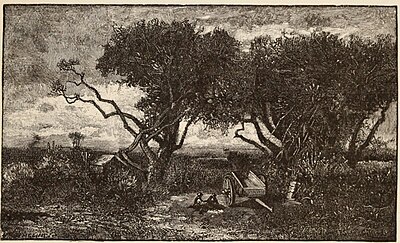
Fig. 81.—The Old Orchard. Engraved by F. Juengling.
Mr. Marsh is one of the older men, and deserves the credit of first showing what wood-engraving is capable of in refinement of line; but younger men have joined him in developing these capacities of the art, and have made work in this style more common. The best of it is by Mr. F. S. King, being equal in every quality to Mr. Marsh's most admirable cuts. Such engraving is exceptional, of course; but the evenness and transition of tone, the care for line, the discrimination of both line and color values, shown in these butterflies (Fig. 77), are characteristic of Mr. King's work in general, although in some of it a lack of definition in outlines is noticeable. The refinement of line in these two engravers is justifiable, because they put meaning into the lines, and express by them something that could not otherwise be interpreted to the eye through this art; and so long as this remains the case they will meet with commendation and encouragement. It is only when such refinement is needlessly resorted to, or is confusing or meaningless, that it is rightly rebuked.
The second and more evil tendency of recent engraving, toward an abandonment of line, is exhibited in many phases, and by nearly all the younger men. In some cases the central portion of the cut seems alone to be cared for, and is much elaborated, while the surrounding parts fade off into the background with the uncertainty of a dissolving view; in other cases there seems to be entire indifference about form or texture: there is no definition of the one nor discrimination in the other, but an effect only is sought for, usually vague or startling, always unsatisfactory, and not infrequently ugly. Such work is the product of ignorance or carelessness or caprice. In it wood-engraving ceases to be an art of expression. These obscure masses, meant for trees, in which one may look with a microscope and see neither leaf, limb, nor bark; these mottled grounds, meant for grass or houses, in which there is neither blade nor fibre; these blocks of formless tints, in which all the veracity of the landscape perishes, do not record natural facts, or convey thought or sentiment; they are simply vacant of meaning. To illustrate or criticise such work would be an ungracious as well as a needless task; but even in the best work of the best engravers, with which alone these pages are concerned, 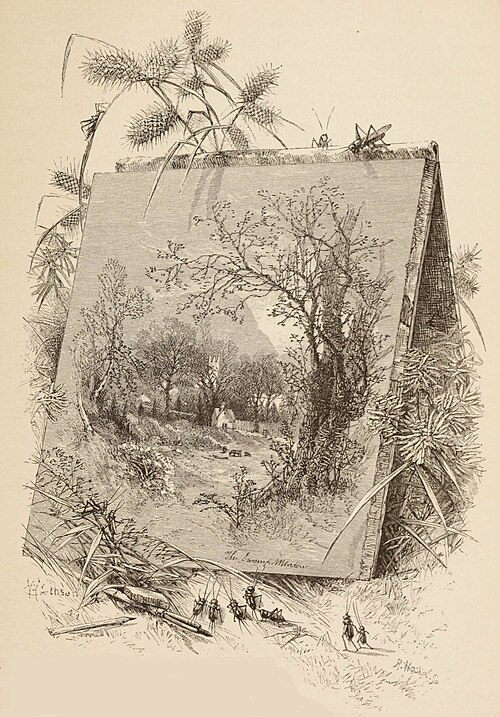
Fig. 82.—Some Art Connoisseurs. Engraved by Robert Hoskin.

Fig. 83.—The Travelling Musicians. Engraved by R. A. Muller.
Of a different order are the two following cuts, simple, quiet, and refined. The mountain scene (page 183) is admirable for the disposition of its lights and shadows, the gradation and variation of its tints, and the subordination of every element to a truthful total effect. The cut by Mr. Hoskin (Fig. 82) is a good example of his always excellent work, showing his power of economy and his feeling for line and tone, while it evinces self-restraint in methods of work.
The change that has taken place in recent engraving has been less marked in cuts of landscape, however, than in cuts of figures. In the former line-arrangement has been affected somewhat, and usually for the worse, but in the latter the transformation has been greater, and the results already worked out of more striking novelty. The development, however, has been in the same directions, in refining or abandoning line, and examples exhibit the same or analogous variation in the engravers' regard for form and texture. The first group here given (Fig. 83) shows clearly, by the character and the direction of its lines, that it is a reproduction of copperplate-engraving, and as a piece of imitative work it is remarkable; the figures are life-like, full of vivacity and force, and the faces are natural and very expressive. It is, however, in the style of copperplate, and in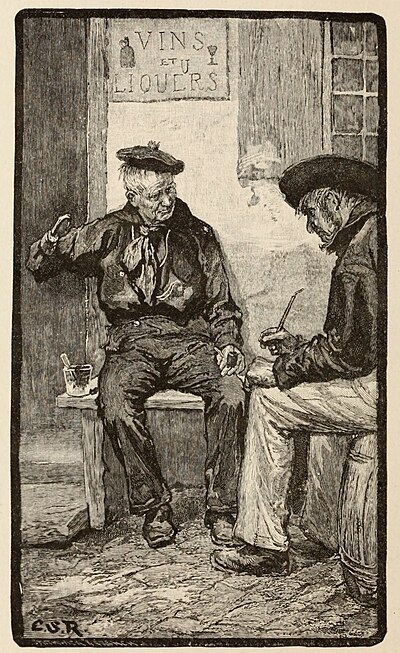
Fig. 84.—Shipwrecked. Engraved by Frank French.
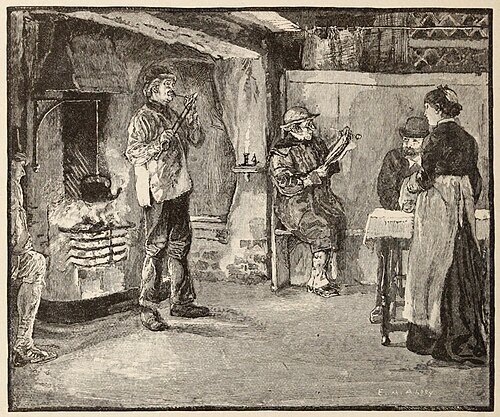
Fig. 85.—The Tap-room. Engraved by Frank French.
which he first became widely known, were remarkable for an entire absence, in some cases, of any demarcation between picture and background, and for a concentration of attention upon some few specially characteristic features of the face. Whoever deserved the blame so liberally meted out to these heads, Mr. Cole's reputation rests now upon better work—upon such an exquisitely refined portrait as that of Modjeska as Juliet, in the Scribner Portfolio of Proofs, and other cuts of hardly less merit there to be found. Frequently, however, there is noticeable in some of his best work an analogous characteristic to that of the earlier portraits—the concentration of attention on the central figures, to the neglect of the minor portions of the designs. Thus in the example here given (Fig. 87), so long as the eye is concerned only with the two stately figures, there is only pleasure in such admirable workmanship; but when the gaze wanders to the near, and especially the remote, background, there is nothing to delight the lover of art or nature in such confusion,
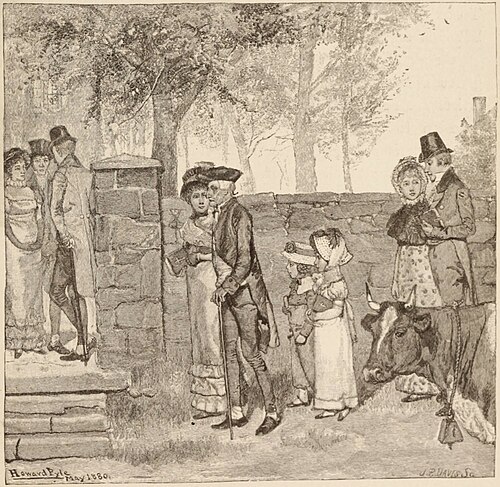
Fig. 86.—Going to Church. Engraved by J P. Davis.
"And all the sunset heaven behind your head?"
This "generalization" of the landscape, as it is called, empties it of all that makes it lovely. To the cut, as an example of figure-engraving, the highest praise may be given, but as an entire picture it is harmed by its imperfection of detail. To subordinate by destroying is not the mode of high art, but it is often the mode of the new school.
Of all the work of recent years, however, the best, it is generally admitted, is in the portraits, possibly because the artists are restrained by the definiteness of the form and expression to be conveyed. Mr. Cole's Modjeska has been already praised, though it is rather a fine figure than a fine portrait. A portrait of Mr. Hunt by Mr. Linton, and of Mr. Fletcher Harper by Mr. Kruell, are also of high merit, and in both a very high level of excellence is sustained. The special character of the new school in portraiture, as a distinct and radical style, is illustrated by Mr. Juengling's "Spanish Peasant" (Fig. 88). It recalls at once the portrait of Whistler by the same hand. In disposition of color, in certainty of effect, and in skill of execution, all must recognize the engraver's power; but is the value of the human face, in whose mouldings is expressed the life of years and generations—is the value of the human eye, in which the light never goes out, truly felt? One cannot help feeling that the brutalizing of this face is a matter rather of art than of truth. Contrast the two portraits here given (Figs. 89, 90), one in the bolder, more definite, larger style, 
With almond clusters in your clasping hand."
Fig. 87.—"Nay, Love, 'tis you who stand
With almond clusters in your clasping hand."Engraved by T. Cole.
admirable in its tones and discrimination of textures, among the very best in this manner; the other finer, with the tendency to fade into the background, but faultless in its rendering of the face, and proving by success the great effectiveness of the fine white cross-line.
These illustrations of recent engraving are sufficiently numerous and various to offer a fair test of what has been done in different branches of the art. The capacity of any new school should be judged by the best it has produced; but, even in this best work, it is not difficult to discern at times the same tendencies that have been the main cause of failure in the less good work. The obscuration of leading outlines; the disregard of substance, shape, and material in leaf, cloud, and stuffs; the neglect of relief and perspective, the crowding of the ground with meaningless lines, either undirected or misdirected, or uselessly refined; the aim at an effect by an arrangement of color almost independent of form, the attempt to make a momentary impression on the eye, instead of to give lasting pleasure to the mind through the artistic sense, and—especially in the best work—the lack of perfect and masterly finish in all portions of the design, however insignificant by comparison with the leading parts—these must be counted as defects. How much of such failure is due to the designer, it is impossible to determine without sight of the original drawings; a considerable portion of the fault may rest with him; in wood-engravings, as art-works, the union of designer and craftsman is inseparable—the two stand or fall together. But when all deductions have been made, the best engravers may rightly be very proud of their work, confident of their future, and hopeful of great things. With such perfect technical skill as they possess, with such form and texture as they have represented with care, truth, and beauty; with such softness 
Fig. 88.—The Spanish Peasant. Engraved by F. Juengling.

Fig. 89.—James Russell Lowell. Engraved by Thomas Johnson.
of tone and power of both delicate and strong line as some of their number have earned the mastery of, the value of future work depends only on the wisdom of their aims. If the fundamental grounds on which the foregoing criticism rests be true, these engravers have won success in so far as they have attended to form and texture as the main business of their art, and they have failed in so far as they have destroyed these. From its peculiar and original powers in the interpretation of form and texture by line-work, either black or white, wood-engraving has derived its value and earned the respect due it as an art, both through its great works in the past and, so far as yet appears, through its best works in the present. Wood-engravers, if the design given them to reproduce is in black line, fit for engraving in wood, must copy it simply, and then, should artist-draughtsmen arise, the art in this manner will again produce works of permanent value as in the days of Holbein; if, on the other hand, the design given them is in color or washed tints, or anything of that sort, they must interpret it by lines of their own creation, and then, too, should any engraver-draughtsmen arise among them, the art will possess a similarly high value; but in no other way than by attending to these two kinds of line-work, separately or together, can wood-engraving remain artistic; and even then its success will depend on the knowledge and skill of the designer, whether artist or engraver, in the use and arrangement of the special lines which are best adapted to the art.
The history of wood-engraving, as it is recorded in the chief monuments of the art, has now been told from its beginning down to the present moment. Its historic and artistic value has been mainly dwelt upon, with the view of showing its utility as a democratic art and its powers as a fine art. It has had an illustrious career. It has shared in the great social movements which transformed mediæval into modern civilization. It entered into the popular life, in its earliest days, by representing the saints whom the people worshipped. It contributed to the cause of popular civilization in the spread of literature. It assisted the introduction of realism into art, and gave powerful aid in the gradual secularization of art. It lent itself to the Italian genius, and was able to preserve something of the loveliness of the Italian Renaissance. It helped the Reformation. It gave enduring form to the imagination and thought of Dürer and Holbein. It fell into inevitable decline; but, when the development of democracy again began in the new age, it entered into the work of popular civilization with ever-increasing vigor and ever-widening influence. It seems still to possess unlimited capacities for usefulness in the future in both the intellectual and artistic education of the people. It may yet crown its career by making this country an art-loving as well as a book-reading Republic.

Fig. 90.— Arthur Penrhyn Stanley. Engraved by G. Kruell.